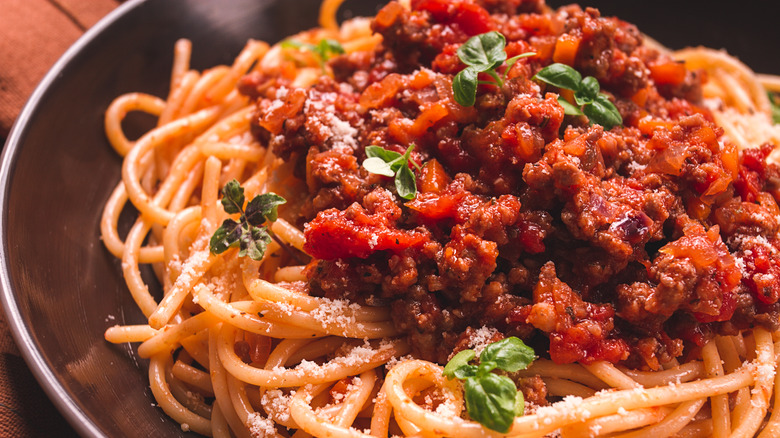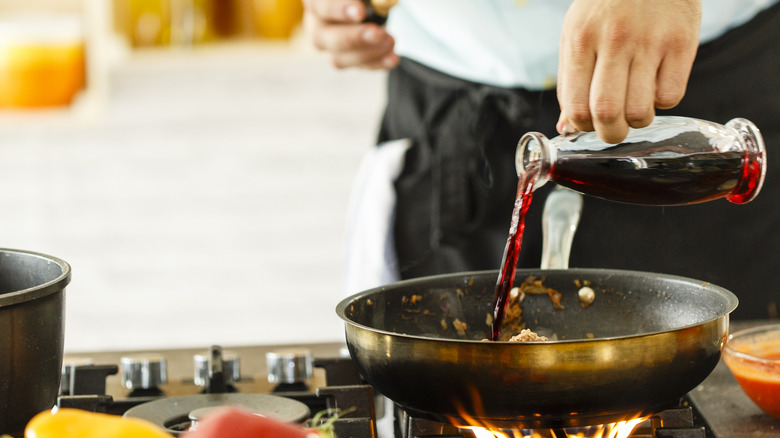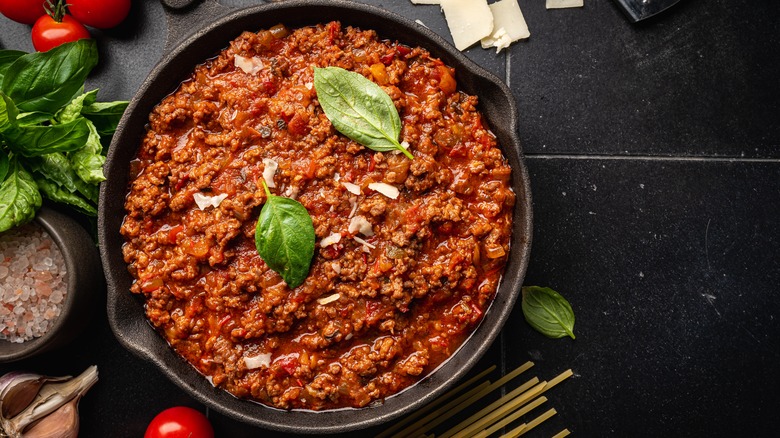The Crucial Step Needed To Perfect Olive Garden's Bolognese Sauce
Most restaurants don't give away the recipes for their signature dishes, and for good reason: it keeps people coming back for more. Olive Garden's recipes however were completely public at one point. Back when the chain still had pizza on its menu, you could simply hop on the website and click on the recipes tab. These recipes included popular menu items such as shrimp scampi, fettuccine alfredo, and a discontinued pineapple tiramisu. The recipe for Bolognese sauce, a long-standing customer favorite, was also shared on the site.
Many recipes for Bolognese sauce are fairly simple, and call for a base of ground beef, onions, and marinara sauce. Olive Garden's Bolognese sauce, according to the since-deleted recipe page, is a bit more complex because it also calls for red wine and a vital deglazing step, which imparts a deeper flavor to the dish. If you're trying to recreate Olive Garden's Bolognese sauce and can't quite figure out why it doesn't taste exactly the same, it may be because you're skipping this step.
Why deglazing is key to Olive Garden's Bolognese sauce
Not everyone can go to Olive Garden's cooking school in Tuscany, but if you want to master the restaurant's Bolognese, luckily it's easy to learn how to deglaze a pan. Deglazing is a step that happens after you finish sautéing or caramelizing something in a pan. Instead of washing away the residue left at the bottom — also known as fond — you add a liquid such as wine to loosen it up. A sauce then begins to form as the liquid cooks down. Deglazing a pan incorporates a bit of extra flavor into the sauce, which explains why people find Olive Garden's Bolognese so tasty.
In Olive Garden's Bolognese recipe, the deglaze step happens after sautéing celery, carrot, onion, garlic for about five minutes over medium heat, followed by ground beef and sausage for another 10. Olive Garden's recipe doesn't specify what type of red wine to use, however in general any dry wine is acceptable for deglazing. Just make sure not to opt for a wine that's been aged in oak, as this may yield a bitter Bolognese sauce.
Does Olive Garden still make Bolognese this way?
If you look on the Olive Garden menu today, you'll notice that the restaurant now refers to its Bolognese sauce as "meat sauce." This could simply be a name change, but it could also indicate that the recipe is different from the original Bolognese. The current menu describes the meat sauce as being made with "pan-seared beef" and Italian sausage, which accurately reflects the deleted recipe. However, it's possible that the beef isn't actually pan-seared.
Back in 2013, Olive Garden shared a picture of its pasta sauce to Facebook along with the caption "#DidYouKnow our sauces are made fresh daily?" But years later in 2021, a former employee revealed this was no longer entirely true. "Your potatoes, your veggies, certain sauces, and some of your meats are just microwaved and put on your plate," the employee claimed in a deleted TikTok reposted to Newsweek. Hopefully that's not the case with Olive Garden's beloved Bolognese sauce, but at least you can always recreate the original. Just make sure not to forget the red wine for that crucial deglazing step.


